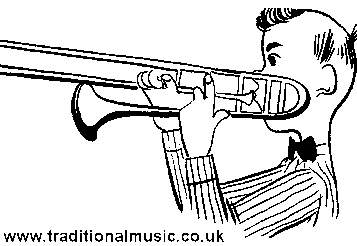It's Easy To Make Music
How To Play The Trombone
| Share page | Visit Us On FB |
THE TROMBONE

The great increase in the number of dance bands has brought
new and widespread popularity to the trombone, which plays
a prominent part in making their music. Expert players can
'produce many novel effects and go in for "rips," "breaks" and
other "hot" maneuvers. For those who like more serious music
the trombone, with its rich golden tones, also has much to offer.
It is an outstanding solo instrument and blends beautifully
with other instruments for informal ensemble playing at home
or in band and orchestra work.
Of all the brass instruments, the trombone has the most
perfect pitch. Each note in its range of more than two octaves
can be played exactly in tune if the slide is handled properly.
Producing Trombone Tones
The trombone is held by the left hand in the manner shown
in Fig. 92. The first finger is put right by the mouthpiece, and
the remaining fingers curl around the upright crosspiece. The
fingers hold the instrument against the palm of the hand to hold
it steady.
The right hand holds and guides the slide, which is moved
in and out to form the notes. It holds the slide by the second
or lower crosspiece, which it grasps between the thumb and
the first two fingers, as shown in Fig. 92. The most important
thing is to have the end of the thumb well positioned at or
near the point where the lower crosspiece and the lower slide
meet, and to keep the thumb there while playing.
When you are ready to start to produce a tone, put the
125